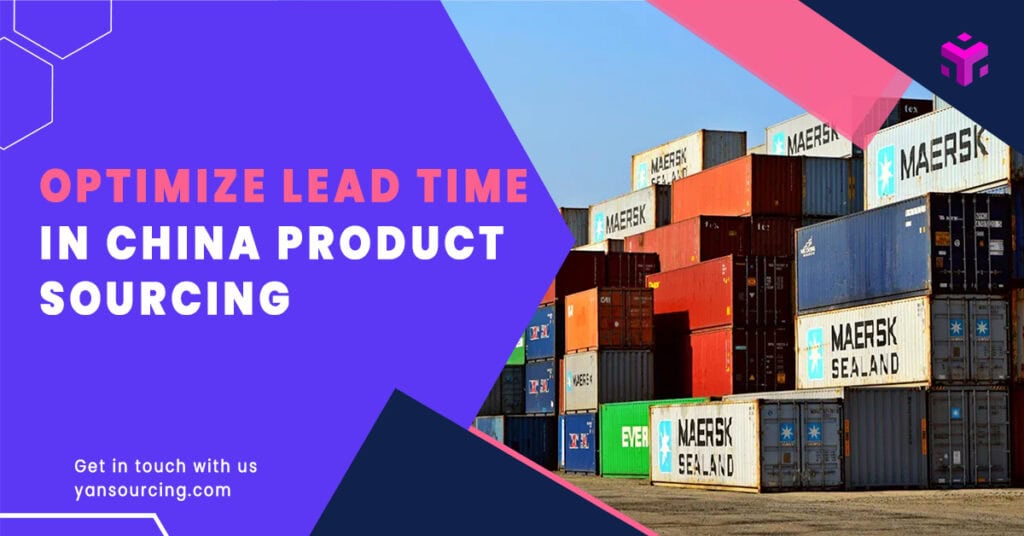
When you buy products from China, lead time is important. Shorter lead times mean faster deliveries, happy customers, and less stress. But bad lead time management can cause too much stock, higher costs, and supply chain problems.
Managing lead times well isn’t just helpful—it keeps you ahead. Research shows better lead times prevent running out of stock and improve service, even during supply chain issues.
Yansourcing helps make this easier for businesses like yours. With experience in sourcing materials, we reduce delays and speed up production and delivery.
Key Takeaways
Shorter lead times mean quicker deliveries and happier buyers. Manage lead times to make your supply chain work better.
Pick trustworthy suppliers to avoid late shipments. Build good relationships and talk clearly to keep things running well.
Use tools like ERP systems to check inventory and plan shipping. This stops items from running out and avoids delays.
Split lead time into steps: ordering, making, checking quality, and shipping. Find ways to save time and work faster.
Learn about customs rules and forms. Correct paperwork stops delays and keeps your supply chain smooth.
Understanding Lead Time in China Sourcing
What is Lead Time in Product Sourcing?
Lead time is how long it takes to get products. It starts when you place an order and ends when you receive it. This is very important when buying from suppliers in China. Managing lead time well helps your business run smoothly and keeps customers satisfied.
Here’s a simple way to understand lead time:
Parameter | What It Means |
|---|---|
Days from when the supplier gets your order to shipping it. | |
Vendor Lead Time | Time from confirming availability to delivering the goods. |
Measurement Formula | Supplier lead time = Delivery date – Order date (when PO is accepted). |
Knowing these details helps you improve your sourcing process.
Parts of Lead Time in China Sourcing
When buying from China, lead time has many parts. Each step affects how fast you get your products:
Order Processing Time: Time for the supplier to confirm and start your order.
Production Time: Time needed to make your products.
Quality Control Time: Checking if products meet your standards before shipping.
Shipping Time: Time to move goods from China to your location.
Breaking these steps down helps you find ways to save time and avoid delays.
Why Lead Time Matters for Supply Chains
Lead time affects how well your supply chain works. Shorter lead times mean quicker deliveries, lower costs, and happier customers. Here’s why it’s important:
Result | What It Means |
|---|---|
Shorter lead times mean faster order handling and delivery. | |
Lower Inventory Costs | Less waiting time means you don’t need to store as much inventory. |
Happier Customers | Delivering on time makes customers trust and like your business more. |
For example, companies like Tesco cut lead times to reduce waste and work better. When you improve lead time, you can adapt to changes and stay ahead of competitors.
Common Challenges in Reducing Lead Times
Cutting lead times in China sourcing can be tricky. Problems like delays, miscommunication, or shipping issues often arise. Let’s look at the main challenges and their effects on your supply chain.
Supplier Delays in China
Supplier delays are a big problem. Factories in China may slow down production due to high demand, fewer workers, or lack of materials. For example, from February to June 2020, imports dropped by 7.4% compared to normal levels. These delays cause longer wait times and late shipments.
To avoid delays, choose dependable suppliers. Build good relationships and set clear rules. Regular updates and tracking production can also help prevent problems.
Communication Barriers with Suppliers in China
Miscommunication can mess up your sourcing plans. Language differences, cultural habits, and time zones make working with Chinese suppliers harder. For example, understanding business customs or agreeing on terms can be confusing.
Here’s how to fix this:
Hire bilingual staff or interpreters to help with language.
Have regular video calls to explain your needs.
Write down all agreements to avoid confusion.
Better communication builds trust and makes teamwork easier.
Logistics and Shipping Constraints
Shipping time is another big issue. Customs rules, crowded ports, and fewer shipping options can slow deliveries. Careful planning is needed to handle these problems. For example, customs require detailed paperwork, labels, and packaging. Missing one step can cause delays.
Work with skilled freight forwarders to simplify logistics. They can plan routes, handle customs, and avoid delays. This helps your products arrive faster and with fewer problems.
Pro Tip: Always have a backup shipping plan. Using different methods can prevent unexpected delays.
By solving these problems, you can cut lead times and keep your supply chain running well.
Regulatory and Customs Delays
Dealing with customs delays can feel confusing when buying from China. These delays happen because of strict rules, missing forms, or miscommunication. If you’re not ready, they can slow deliveries and raise costs.
What causes these problems? Here are the main reasons:
Incomplete Documentation: Missing or wrong forms like invoices or certificates can stop shipments.
Customs Inspections: Random checks or flagged goods can delay shipments for days.
Regulatory Changes: New trade rules or tariffs can surprise you if you’re not updated.
Tip: Always check your paperwork carefully before shipping. Small errors can cause big delays.
How can you avoid these problems? Work with a sourcing partner who knows China’s customs process well. For example, Yansourcing helps businesses handle these issues. They make sure all forms are correct and follow the rules. This saves time and avoids delays.
Another good idea is to hire a trusted freight forwarder. They know customs rules and can fix problems quickly. Many also have connections with customs officials, which speeds things up.
Lastly, stay updated on trade rules. Sign up for updates or work with experts who can warn you about changes. Being prepared helps you avoid surprises and keeps your supply chain running smoothly.
Remember: Customs delays happen often, but good planning can reduce their impact. Stay organized and keep your products moving.
Strategies for Optimizing Lead Time in China Sourcing

Getting products faster from China can be tricky. But using smart strategies makes it easier. This section shows ways to cut delays and work better. Let’s explore.
Partnering with Reliable Suppliers in China
Picking good suppliers is key to smooth sourcing. Reliable suppliers help avoid delays and keep quality high. They also make your supply chain stronger. Here’s why they matter:
Cost Savings: Reliable suppliers often give better prices.
Enhanced Efficiency: They produce faster with fewer mistakes.
Stronger Supply Chain: Dependable suppliers lower risks and improve results.
Check supplier reviews and past work to find good ones. Certifications and strong records are helpful. Build trust by talking often and setting clear rules. For example, Nike works well with suppliers to speed up production and cut lead times.
Tip: Track supplier performance with metrics. Fix problems quickly.
Leveraging Technology for Lead Time Optimization
Technology helps speed up sourcing. Tools like AI and IoT make decisions faster and reduce errors. Here’s how they help:
Key Takeaways | Description |
|---|---|
Better Forecasting | Predict demand to avoid running out of stock. |
Real-Time Monitoring | Track shipments to know delivery times. |
Lean Practices | Automation speeds up work and reduces mistakes. |
IoT sensors can track products live. This gives updates and helps adjust plans quickly. Machine learning can also improve inventory management for faster deliveries.
Pro Tip: Use tools with data analytics and automation. They save time and boost efficiency.
Reducing Batch Sizes for Faster Production
Smaller batches make production quicker. They reduce waiting, mistakes, and risks. Here’s what happens:
Evidence Type | Description |
|---|---|
Cycle Time Reduction | Shorter queues mean faster production. |
Variability Decrease | Fewer changes prevent delays. |
Accelerated Feedback | Quick fixes solve problems faster. |
Risk Reduction | Lower failure rates improve reliability. |
Smaller batches help spot defects early and fix them fast. This cuts waste and keeps things running smoothly. Working this way speeds up production without losing quality.
Note: Talk with suppliers to use smaller batches. It takes teamwork but saves time.
Optimizing Logistics and Transportation Routes
Getting products from China to you quickly needs good planning. Managing logistics and transportation well saves time and money. It also makes sourcing smoother. Let’s see how this works.
Why Logistics Optimization is Important
Better logistics means fewer delays and on-time deliveries. This is crucial when sourcing from China. Long distances and tricky shipping steps can slow things down. By improving transportation routes, you can avoid problems like crowded ports or unexpected stops.
Ways to Improve Logistics
Here are simple ways to make logistics and transportation better:
Track Key Metrics: Check delivery times, fuel use, and customer happiness. This shows where to improve.
Study Shipping Data: Look at past deliveries, traffic, and weather to plan better.
Use Real-Time Updates: Tools with live traffic and weather info help avoid delays.
Strategy | What It Does |
|---|---|
Track Metrics | Watch delivery times and fuel use to find issues. |
Study Data | Use past info to predict and improve delivery routes. |
Real-Time Tools | Adjust routes quickly with live traffic and weather updates. |
Using predictive tools can also help. They look at past data to guess traffic and adjust routes before trips. This ensures faster and smoother deliveries.
Pro Tip: Work with skilled freight forwarders who know China’s shipping system. They can help with customs, pick the best routes, and avoid delays.
Using Yansourcing’s Help for Building Materials
If you need building materials from China, Yansourcing is a great partner. With over 10 years of experience, they make sourcing easy and fast.
How Yansourcing Saves You Time
Yansourcing handles every part of the sourcing process. From finding good suppliers to managing logistics, they do it all. Here’s how they help:
Trusted Suppliers: They work with reliable suppliers to get quality materials at good prices.
Product Checks: They inspect items before shipping to avoid defects and delays.
Logistics Help: They manage storage, shipping, and customs to save time.
Custom Solutions for Building Materials
Yansourcing can source many building materials like furniture, lights, and bathroom items. They also offer custom designs to fit your needs. This ensures you get exactly what you want for your projects.
Did You Know? Yansourcing recently delivered 10,000 custom perfume bottle covers in just 55 days. Their smart sourcing and logistics made it happen.
Why Pick Yansourcing?
By choosing Yansourcing, you benefit from their deep knowledge of China sourcing. They handle the hard parts, so you can focus on growing your business. Their customer-first approach ensures your needs are always met.
Take Action: Want to improve your sourcing? Visit Yansourcing’s website to learn more about their services and how they can help you.
Case Studies: Successful Lead Time Optimization

Example 1: Cutting Lead Time with Supplier Checks
Checking suppliers often can help reduce lead times. By reviewing their work, you can find and fix problems early. These checks look at how fast they produce, their quality checks, and if they deliver on time. This helps ensure they meet your needs and stick to schedules.
Imagine you’re buying building materials from China. A supplier check might show slow machines or issues in their process. Fixing these problems can speed up production and improve delivery times. Regular checks also build trust, making suppliers more likely to focus on your orders.
Tip: Check suppliers twice a year. Use a list to review speed, quality, and communication.
Example 2: Using ERP Tools for Better Inventory Control
ERP tools are great for managing stock and saving time. They help track inventory, predict needs, and make work smoother. With live data, you can avoid having too much or too little stock.
Here’s how ERP systems help businesses:
Study Title | Industry | Key Benefits | Measurable Outcomes |
|---|---|---|---|
Financial advantages of leveraging SAP S/4HANA Integration in retail | Retail | Improved efficiency, cost savings, better customer experience | Cost savings, increased revenue, streamlined operations |
ERP: A Key Tool For Cost And Time Savings | Manufacturing, Retail | Reduced inventory holding costs, improved order delivery times | 20% reduction in inventory costs, 15% improvement in delivery times |
Walmart’s Custom SAP ERP Solution for Operational Excellence | Retail | Enhanced operational efficiency, reduced costs | Improved workflows, better coordination, reduced delays |
These examples show how ERP tools can improve sourcing. For instance, using smart predictions helps plan stock better and avoid delays from shortages.
Pro Tip: Pick ERP tools that connect with your suppliers’ systems. This makes orders faster and easier.
Example 3: Yansourcing’s Help in Faster Building Material Sourcing
Yansourcing is a trusted partner for cutting lead times in China sourcing. They specialize in building materials and ensure quick production and delivery. From picking suppliers to handling shipping, they save you time and effort.
For example, Yansourcing helped deliver 10,000 custom perfume bottle covers in 55 days. They managed suppliers, checked quality, and handled shipping smoothly. This shows their skill in managing tough projects while keeping high standards.
When sourcing items like furniture or lights, Yansourcing ensures timely and quality deliveries. Their strong supplier network and smart logistics make them a top choice for businesses wanting faster lead times.
Take Action: Check out Yansourcing’s website to learn how they can simplify your sourcing process.
Conclusion
Improving lead time in China sourcing isn’t only about speed. It’s also about creating a better supply chain to stay competitive. You can cut delays by working with trusted suppliers, using smart tools, and fixing shipping issues.
Yansourcing helps make this simpler. They are experts in sourcing and supply chains. They solve problems and get better results for your business. Want to learn more? Check out Yansourcing’s website to see how they can help you.
FAQ
1. What’s the best way to cut lead time in China sourcing?
Work with trusted suppliers and use tools like ERP systems. These tools help track production and shipping progress. Experts like Yansourcing make the process easier, from picking suppliers to delivery.
2. How can I stop delays from customs?
Check all documents carefully and know the latest rules. A sourcing agent like Yansourcing can help. They handle customs forms and follow rules, saving time and avoiding delays.
3. Why is talking with suppliers so important?
Good communication avoids mistakes about product details and timelines. Regular updates and written agreements are helpful. Yansourcing helps with language and culture differences for smooth supplier interactions.
4. Do smaller orders really make production faster?
Yes, smaller batches take less time to produce and check. They also lower mistakes. Talk to your supplier to find a good balance for both sides.
5. How does Yansourcing improve lead time?
Yansourcing manages everything—from finding suppliers to shipping goods. They check quality, handle documents, and plan shipping well. Their experience in sourcing building materials saves time and reduces risks.

